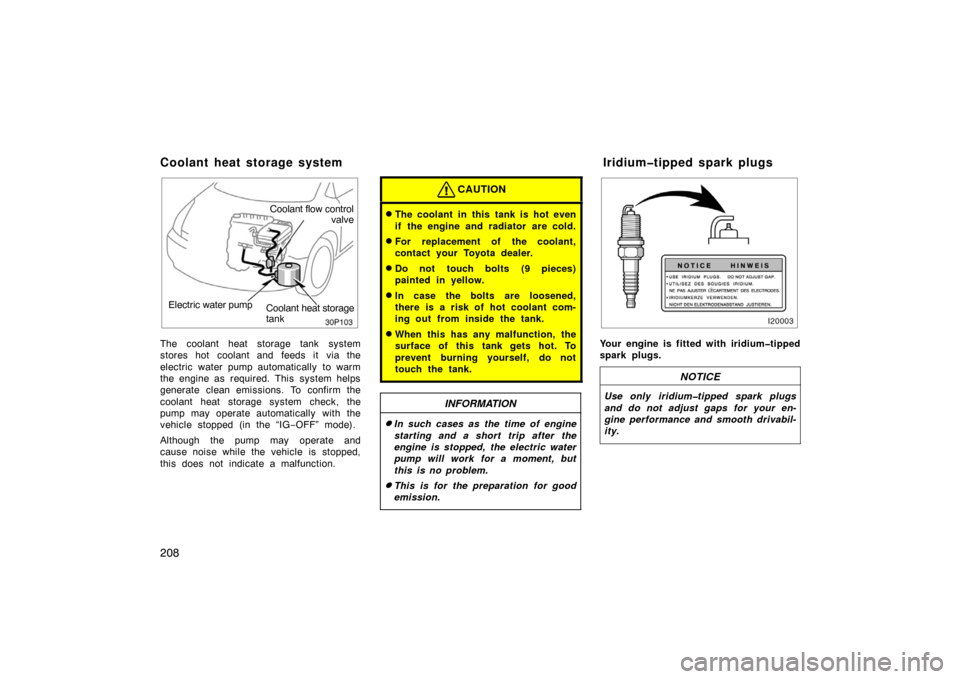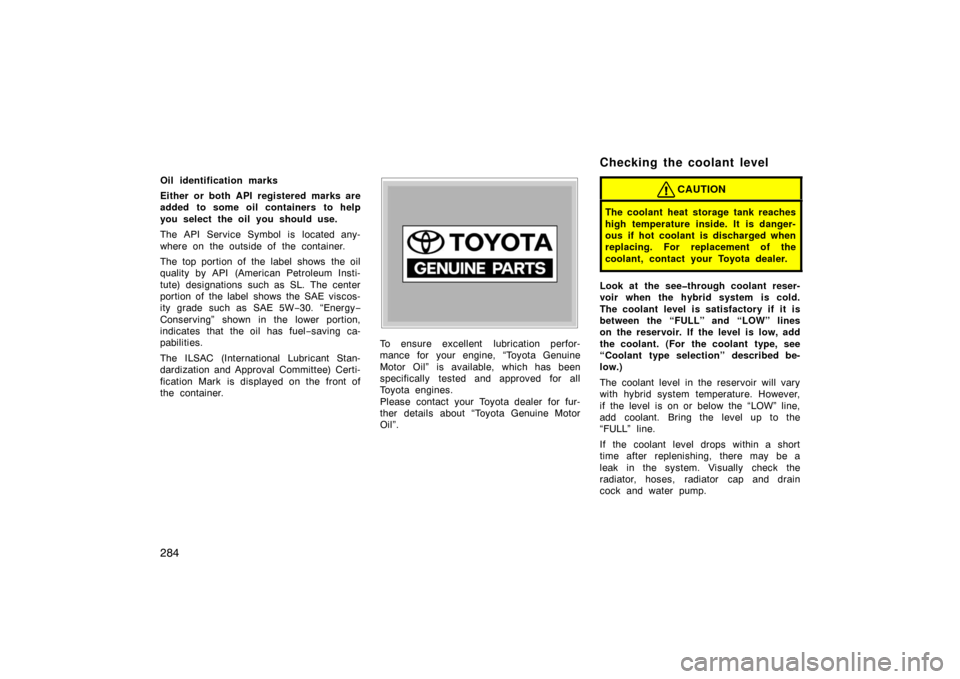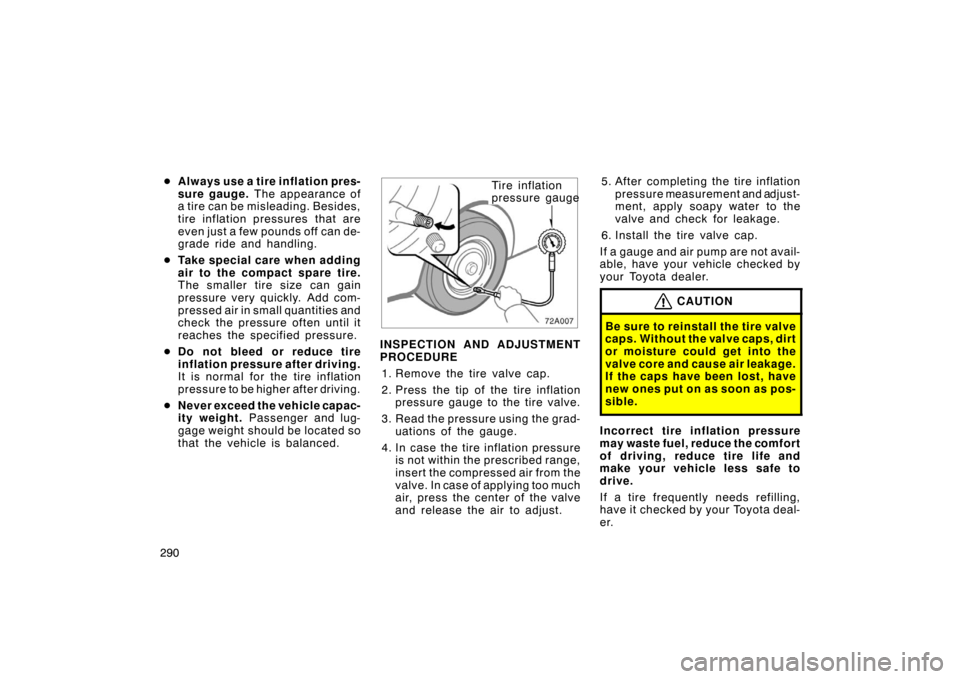Page 208 of 333

208
30p103
Electric water pumpCoolant heat storage
tank
Coolant flow control
valve
The coolant heat storage tank system
stores hot coolant and feeds it via the
electric water pump automatically to warm
the engine as required. This system helps
generate clean emissions. To confirm the
coolant heat storage system check, the
pump may operate automatically with the
vehicle stopped (in the “IG −OFF” mode).
Although the pump may operate and
cause noise while the vehicle is stopped,
this does not indicate a malfunction.
CAUTION
�The coolant in this tank is hot even
if the engine and radiator are cold.
�For replacement of the coolant,
contact your Toyota dealer.
�Do not touch bolts (9 pieces)
painted in yellow.
�In case the bolts are loosened,
there is a risk of hot coolant com-
ing out from inside the tank.
�When this has any malfunction, the
surface of this tank gets hot. To
prevent burning yourself, do not
touch the tank.
INFORMATION
�In such cases as the time of engine
starting and a short trip after the
engine is stopped, the electric water
pump will work for a moment, but
this is no problem.
�This is for the preparation for good
emission.
Your engine is fitted with iridium�tipped
spark plugs.
NOTICE
Use only iridium�tipped spark plugs
and do not adjust gaps for your en-
gine performance and smooth drivabil-
ity.
Coolant heat storage system Iridium�tipped spark plugs
Page 284 of 333

284
Oil identification marks
Either or both API registered marks are
added to some oil containers to help
you select the oil you should use.
The API Service Symbol is located any-
where on the outside of the container.
The top portion of the label shows the oil
quality by API (American Petroleum Insti-
tute) designations such as SL. The center
portion of the label shows the SAE viscos-
ity grade such as SAE 5W−30. “Energy −
Conserving” shown in the lower portion,
indicates that the oil has fuel −saving ca-
pabilities.
The ILSAC (International Lubricant Stan-
dardization and Approval Committee) Certi-
fication Mark is displayed on the front of
the container.
To ensure excellent lubrication perfor-
mance for your engine, “Toyota Genuine
Motor Oil” is available, which has been
specifically tested and approved for all
Toyota engines.
Please contact your Toyota dealer for fur-
ther details about “Toyota Genuine Motor
Oil”.
CAUTION
The coolant heat storage tank reaches
high temperature inside. It is danger-
ous if hot coolant is discharged when
replacing. For replacement of the
coolant, contact your Toyota dealer.
Look at the see�through coolant reser-
voir when the hybrid system is cold.
The coolant level is satisfactory if it is
between the “FULL” and “LOW” lines
on the reservoir. If the level is low, add
the coolant. (For the coolant type, see
“Coolant type selection” described be-
low.)
The coolant level in the reservoir will vary
with hybrid system temperature. However,
if the level is on or below the “LOW” line,
add coolant. Bring the level up to the
“FULL” line.
If the coolant level drops within a short
time after replenishing, there may be a
leak in the system. Visually check the
radiator, hoses, radiator cap and drain
cock and water pump.
Checking the coolant level
Page 290 of 333

290�
Always use a tire inflation pres-
sure gauge. The appearance of
a tire can be misleading. Besides,
tire inflation pressures that are
even just a few pounds off can de-
grade ride and handling.
� Take special care when adding
air to the compact spare tire.
The smaller tire size can gain
pressure very qu ickly. Add com-
pressed air in small quantities and
check the pressure often until it
reaches the specified pressure.
� Do not bleed or reduce tire
inflation pressure after driving.
It is normal for the tire inflation
pressure to be higher after driving.
� Never exceed the vehicle capac-
ity weight. Passenger and lug-
gage weight should be located so
that the vehicle is balanced.
Ti r e inf lat ion
pressure gauge
INSPECTION AND ADJUSTMENT
PROCEDURE 1. Remove the tire valve cap.
2. Press the tip of the tire inflation pressure gauge to the tire valve.
3. Read the pressure using the grad- uations of the gauge.
4. In case the tire inflation pressure
is not within the prescribed range,
insert the compressed air from the
valve. In case of applying too much
air, press the center of the valve
and release the air to adjust. 5. After completing the tire inflation
pressure measurement and adjust-
ment, apply soapy water to the
valve and check for leakage.
6. Install the tire valve cap.
If a gauge and air pump are not avail-
able, have your vehicle checked by
your Toyota dealer.
CAUTION
Be sure to reinstall the tire valve
caps. Without the valve caps, dirt
or moisture could get into the
valve core and cause air leakage.
If the caps have been lost, have
new ones put on as soon as pos-
sible.
Incorrect tire inflation pressure
may waste fuel, reduce the comfort
of driving, reduce tire life and
make your vehicle less safe to
drive.
If a tire frequently needs refilling,
have it checked by your Toyota deal-
er.